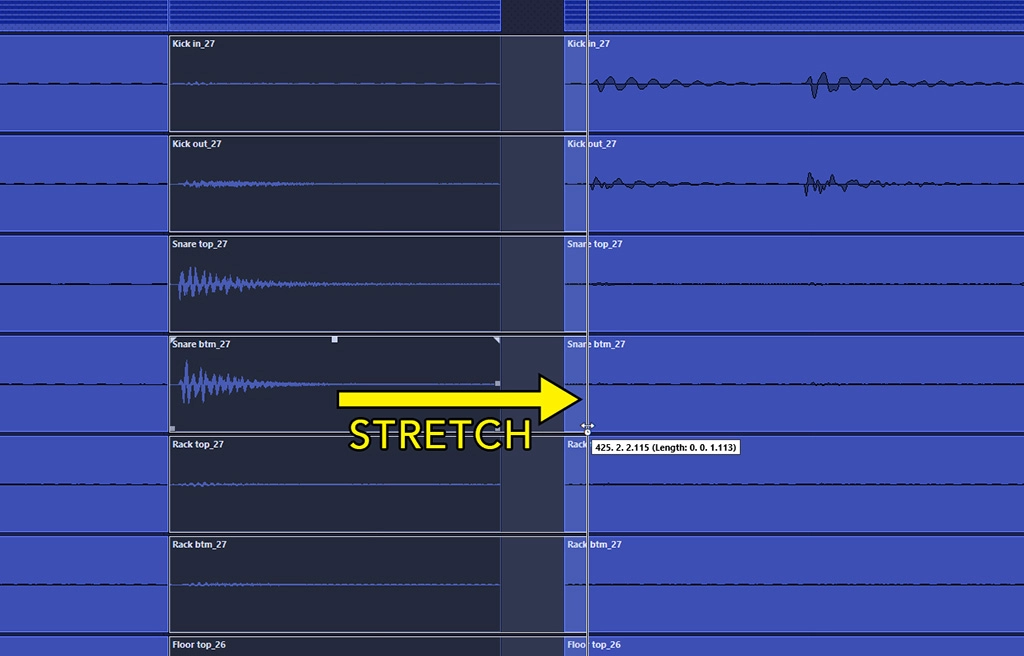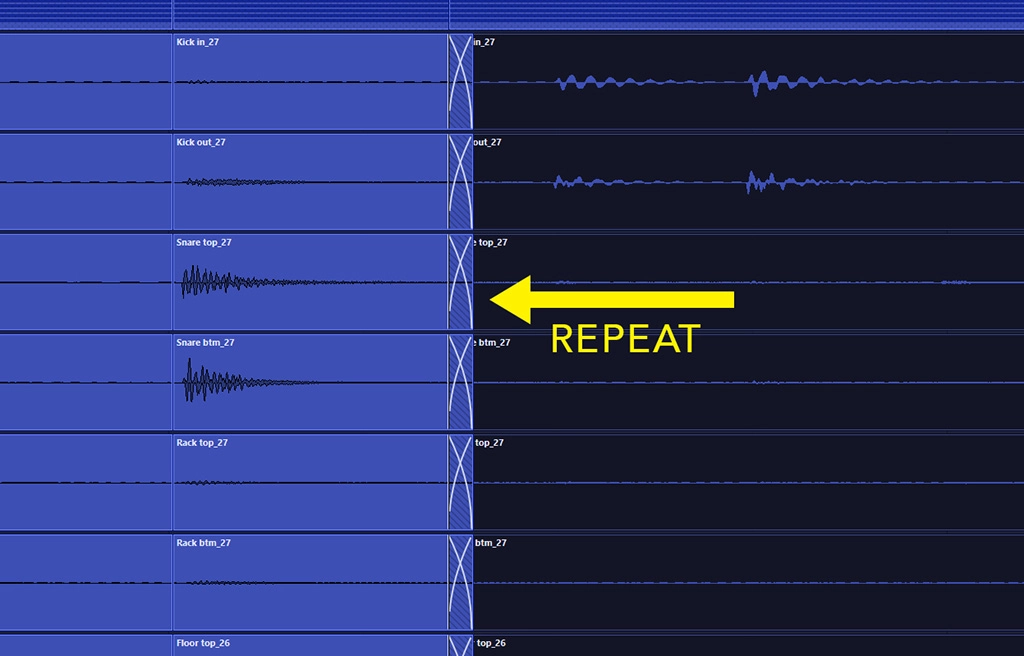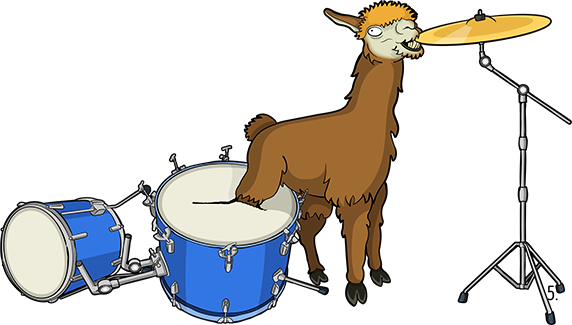By far the biggest hold-up that can impose itself on a recording session is drum editing. It’s a colossal pain in the arse that you really want to avoid, because it’ll gobble up time and money like Pac-Man gobbles up his brain medicine.
Drum editing typically takes place after the initial tracking session. We will review each take for each song, select the best versions and then line these up next to each other within the project, maybe making sweeping decisions such as stitching the first half of take 1 to the second half of take 2. Once satisfied, I will spend a bit of time aligning the grid of the DAW to these recordings so that the project ruler synchronises to the natural ebb and flow of the performances (see the article To Click Or Not To Click for discussion on why this is preferable to making the drummer play to a metronome). This then provides a basis to make any fine-tuned adjustments as necessary, and also makes mixing much more straightforward later on.
Sessions that run quickest and easiest are, without a doubt, those in which drum editing can be kept to an absolute minimum.
So why might we want to do any drum editing at all?
In short, it’s to fix a poor drum performance.
Fixing a poor drum performance is necessary if your song wants to stand any chance of sounding good, because the drum sound and performance is the backbone of your recording. I wouldn’t be the first to make the claim; got a good drummer? You got a good band.
A poor drum performance may come in a variety of flavours, but several factors usually contribute to the necessity of tweaking it after it has been recorded. Let’s have a look at some, and hopefully it will help your band to prepare for your session:
- The drums are not tight.
A drum beat needs to be as solid as possible. Practice to a metronome, and specifically practice where those kicks and snares are landing. Never mind your fancy fills, concentrate on holding down a solid groove. This is what’s going to make your song rock.
- The drums are not consistent.
While you’re practising to a metronome, also concentrate on making your strikes consistent. A poorly hit snare cannot be fixed by just slapping compression on top. If you find yourself wondering why the snare isn’t consistently cutting through the mix, this is your answer.
- Glancing blows to the toms.
When drummers perform rolls around the kit they often deliver glancing blows to the toms, carried by momentum rather than force. This won’t cut through a mix, and I’ll end up isolating the toms and probably replacing them with individually recorded strikes. Make sure those toms are struck definitively, with purpose, rather than lightly glazed with a soggy fish.
- Glancing blows to the cymbals.
Ditto.
- The drums are too complicated.
A simple groove played well is worth more than an overcomplicated mess. Your audience wants to dance. Don’t confuse them.
- Too much material in too little time.
Don’t be a hero. Drumming is knackering. If you want to record 5 songs in a day, and you do 3 takes of each song, that’s 15 songs you’re going to be playing. Reckon you can maintain consistent power and timing for 15 songs? Even if you can hold it for a while, by the time you reach song 5, you’re already up to your 13th take. Don’t be surprised if song 5 is significantly floppier than song 1.
- Poor equipment.
A good drum kit, set up well and played with precision, basically records itself. It makes my job incredibly easy. Any time a recording session went quickly and flawlessly was in large part due to the drummer being excellent and on the ball with his equipment. Don’t turn up with snare wires hanging off and skins that have never been changed. If in doubt, ask. I’m always happy to help.
- Poor tuning.
I’ve heard many drummers worry that they don’t really know what they’re doing with tuning, so they hand the drum key to me to sort it for them. Again, happy to help, but come on! There’s like a billion videos on YouTube about how to tune a kit. It’s really not rocket science. Look, here’s one right here! Get on it.
- Lack of rehearsal.
You should train for a recording session like you’re training for a marathon, especially if you’re a drummer. You should know the songs inside out and have all those tricky bits nailed before you set foot in the studio. They won’t magically emerge just because you’re in the studio now. In fact, the studio environment will only put greater pressure on your performance, and your struggles in those problematic bits are going to be magnified for all to witness.
- Long, complicated songs.
If you’re a heavy band performing epic 7-minute tracks, unless you are in peak physical condition, your performance is going to wane as the song goes on. Again, it’s not uncommon for me to hear “the snare seems to lack power in the second half of the song”. Yep, that’s because you’re not hitting it as hard. So either train to overcome the inevitable depletion in endurance, or accept your limitations and break the song down into manageable chunks that we can splice together later.
- Wrong tempo.
Well before the recording session, download a metronome app on your phone and work out what the perfect starting tempo is for each song. Every time you practice, start by tapping that tempo on the high-hat. Get it locked into the group consciousness, otherwise you’ll be complaining that the song is the wrong speed after you’ve recorded it, or you’ll waste time listening through takes trying to work out which one is the correct speed.
- Double-kick drum pedal.
These things are sent straight from Satan, and not because they sound “evil”, but because no fucker can play them, resulting in a flubby mess bouncing around a-rhythmically underneath the track. If you must use one, be sure that you’re good at it. It requires metronomic precision, otherwise it just sounds shit.
- Too much equipment.
It’s funny how there’s often an inverse correlation between the amount of accessories, extra drums, splash cymbals, gadgets and gizmos mounted around the kit, and the technical ability of the drummer. Do a simple thing well. Don’t overcomplicate life.
- Stop being so hard on yourself.
Drummers are human beings, and the drum sound should therefore not be quantised to sound rigid and mechanical. Drum editing is only necessary when it’s necessary, so stop worrying about tiny micro-pushes here and there. Those things are beautifully human, and there’s no need to spiral into a cascade of depression over them. I’m sure there are about 40 other points that will later spring to mind regarding preparation for your drum recording, but that just about covers the fundamentals.
How I Edit Drums
Generally, it’s not uncommon for some degree of drum editing to take place, even if it’s relatively minor. A wonky fill here and a little slip there is pretty inevitable, and fixing one or two issues like that in an otherwise good take is not a big deal. I’m not enough of a purist to insist that those things be left untouched, and sufficiently zealous to feel no bones about nudging them into place. The problems begin when the scale of the correction is much more comprehensive. If the drums are fundamentally flawed for one of the reasons listed above, then you can expect the amount of time to correct it to go into the hours or days. Drum correction can be quite tricky, depending on the complexity of the material and the extent to which things need to be nudged around. It’s very important to maintain phase coherence between all the drum channels in question, and so it’s also important that the project is organised in such a way that the chances of making a mistake and moving something out of alignment are diminished. This reinforces the need for robust project maintenance; colour-coding, grouping and naming all serves a higher purpose than simply making the project look pretty. With the drum channels grouped, there are generally two methods of altering a performance. One is to use a DAW’s inbuilt time-stretching tool, and another is to manually chop it up, nudge it around, and cross-fade it back together. I always go for the latter.






